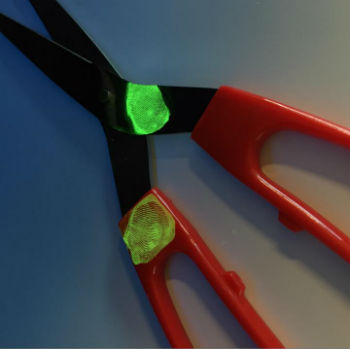Glowing fingerprints
New technique allows instant visualization
Eugene M. McCarthy - 10/21/2015

Glowing fingerprints: New method quickly visualizes fingerprints on any non-porous surface. Photo: CSIRO (Enlarge)
A new treatment creates glowing fingerprints that will make crime scene investigation faster and easier for police investigators. The new technique, developed by an Australian scientist, makes fingerprints glow bright green in ultraviolet (UV) light.
All you have to do is apply a special liquid to the surface you're investigating — whether it's plastic, glass or metal — and hold up a UV lamp. In half a minute fingerprints will glow green and their individual whorls, unaltered, will become clearly visible.
CSIRO materials scientist Dr Kang Liang came up with the new method after his own home had been burgled and the police had been unable to find any prints.
"It got me thinking," he said. "What if I could apply some of the special materials I'd been working with in the lab and come up with a new, potentially better fingerprinting technique?
Glowing fingerprints: A faster, better technique
The new technique not only visualizes fingerprints instantly, allowing them to be photographed and entered into crime databases at once, but also makes it possible to get higher resolution images due to the greater contrast between the latent print and surface in comparison with traditional techniques.
"Because it works at a molecular level," says Liang, "it's very precise and lowers the risk of damaging the print."
The research underlying the new technique was published in the the journal Advanced Materials today. The study shows that microscopic crystals in the solution rapidly bind fingerprint residue, including proteins, peptides, fatty acids and salts, creating an ultrathin coating that's an exact replica of the original pattern. The method proved successful on a range of nonporous surfaces, including window and wine glass, metal instruments and plastic light switches.
Fingerprinting as a forensic technique has been around since the early 1880s, when they were first popularized by Mark Twain, among others, in his book, Life on the Mississippi, in which a murderer is identified by the use of fingerprints. But fingerprinting techniques haven't changed much in over a century.
"Knowing that dusting has been around for a long time, I was inspired to see how new innovative materials could be applied to create even better results," said Liang. "As far as we know, it's the first time that these extremely porous metal organic framework (MOF) crystals have been researched for forensics."
This story was based on information obtained from CSIRO. Source >>
Most shared on Macroevolution.net:
Human Origins: Are we hybrids?
On the Origins of New Forms of Life
Mammalian Hybrids
Cat-rabbit Hybrids: Fact or fiction?
Famous Biologists
Dog-cow Hybrids
Georges Cuvier: A Biography
Prothero: A Rebuttal
Branches of Biology
Dog-fox Hybrids
